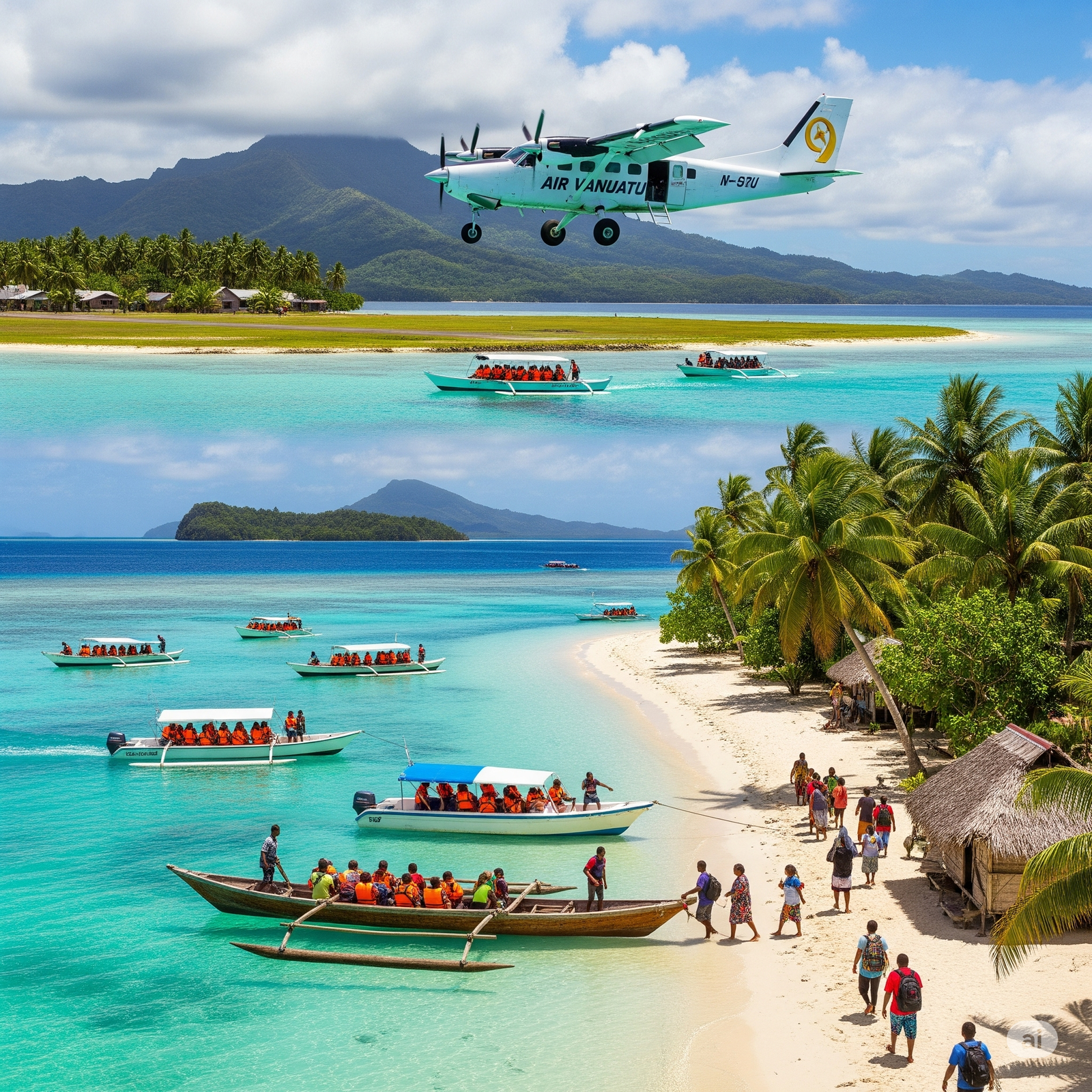Vanuatu, with its 80+ islands scattered across the South Pacific, is a dream destination for adventurers. But with so many unique islands offering everything from active volcanoes to pristine beaches and ancient cultures, the question quickly becomes: how do you actually get around?
Unlike some island nations with well-established ferry networks, navigating Vanuatu’s archipelago requires a bit more planning and an understanding of the available transport options. Here’s your essential guide to island hopping in Vanuatu, ensuring your journey between paradises is as smooth as possible.
1. Domestic Flights: The Fastest (and Often Best) Option
For covering longer distances between major islands, domestic flights are king. Vanuatu’s domestic airline, Air Vanuatu, operates regular services connecting the main hubs.
- Key Routes: The most common routes connect Efate (Port Vila’s Bauerfield International Airport – VLI) to Espiritu Santo (Santo Pekoa International Airport – SON), Tanna (Whitegrass Airport – TAH), Malekula (Norsup Airport – NUS), Pentecost (Sara Airport – SSR), and a handful of other smaller islands.
- Benefits:
- Speed: Minimizes travel time, allowing you to maximize your island experience.
- Accessibility: Reaches islands that are otherwise difficult or time-consuming to get to.
- Views: Flying over the archipelago offers breathtaking aerial views of the islands, reefs, and volcanoes.
- Considerations:
- Cost: Domestic flights are generally the most expensive option. Book in advance, especially during peak season, to secure better fares.
- Schedule Changes: “Island time” applies to flight schedules. Be prepared for potential delays or minor adjustments, especially for flights to smaller airfields. Don’t plan tight connections.
- Baggage Allowance: Check Air Vanuatu’s specific baggage limits, as they can be stricter on smaller planes.
- Booking: You can book directly on the Air Vanuatu website. Sometimes, your local tour operator can also assist with bookings as part of a package.
2. Cargo Ships & Ferries: The Adventurous, Budget-Friendly (but Slow) Choice
For those with more time, a tighter budget, or a desire for a truly local experience, inter-island cargo ships and a limited number of passenger ferries offer a unique way to travel.
- Cargo Ships: These are the backbone of inter-island transport for goods and often take passengers too. They operate on flexible schedules, sometimes departing only when full or when weather permits.
- Benefits: Very affordable, offers a genuine local experience, and you’ll see remote coastal villages.
- Considerations: Can be very slow (days for longer routes), basic amenities (often just deck space), unpredictable schedules (confirm departure times on the day), and subject to weather delays. Not for the faint of heart or those prone to seasickness.
- Inter-Island Ferries: There are fewer dedicated passenger ferries. One notable route is between Efate (Port Vila) and Malekula/Santo on specific days, operated by companies like “The Big Sista.”
- Benefits: More comfortable than cargo ships, fixed schedules (though still subject to change).
- Considerations: Still slower than flying, and routes are limited.
- Booking: For cargo ships, enquire at the wharves in Port Vila or Luganville. For passenger ferries like The Big Sista, check their website or local agents.
3. Smaller Boats & Water Taxis: For Short Hops & Coastal Access
Once you’re on a larger island, smaller boats and local water taxis become essential for reaching adjacent islets or remote coastal areas.
- Resort Boats: Many resorts, especially those on outer islands or private islets (like those around Port Vila), offer their own boat transfers for guests.
- Local Charters: You can often hire local banana boats or dinghies for short trips between islands, or to reach specific beaches and snorkeling spots. Negotiate the price beforehand.
- Benefit: Flexibility and access to places larger vessels can’t reach.
- Considerations: Safety standards can vary, always check life jackets, and ensure the boat is not overloaded. Negotiate clearly.
4. Getting Around On the Islands:
Once you land on an island, your transport options usually include:
- Taxis & Buses (Efate & Santo): In Port Vila and Luganville (Santo), taxis are readily available. Local public transport “buses” are typically minivans that operate on flexible routes – just wave them down!
- Rental Vehicles: Car and 4×4 rentals are available on Efate and Santo. A 4×4 is highly recommended for exploring rural areas, as roads can be unpaved and rugged.
- Trucks (Outer Islands): On outer islands, local pickup trucks (often called “utes” or “trucks”) serve as the main form of public transport, picking up passengers along routes. They’re an authentic way to travel.
- Walking: For short distances within villages or to nearby natural attractions, walking is often the best way to soak in the local atmosphere.
Planning Your Island Hopping Itinerary:
- Prioritize: Decide which 2-3 main islands are your absolute must-sees.
- Buffer Time: Always build in extra time between connections, especially for domestic flights and inter-island boats, to account for “island time” delays.
- Book Major Flights in Advance: Secure your inter-island flights as soon as your international flights are confirmed.
- Embrace Flexibility: Vanuatu is an adventure. Be prepared for things not always going exactly to plan, and enjoy the unexpected detours.
- Engage with Locals: Don’t hesitate to ask locals for advice on transport. They are incredibly helpful and will often know the best ways to get around.
Island hopping in Vanuatu is an unforgettable part of the adventure. By understanding the transport options and approaching your journey with an open mind, you’re set for an incredible exploration of this truly unique archipelago.


Leave a Reply